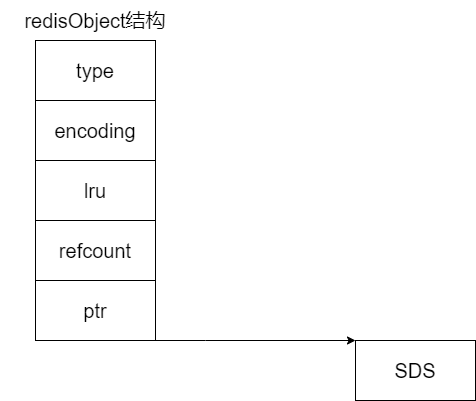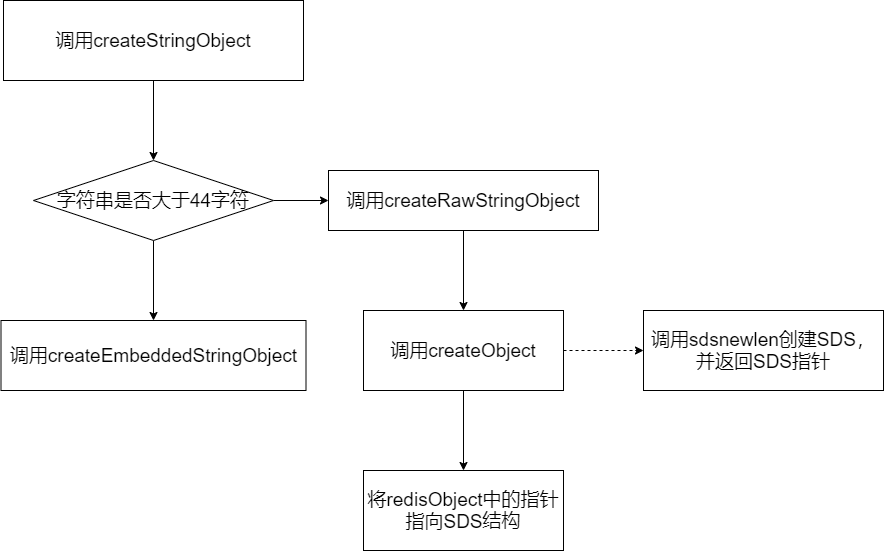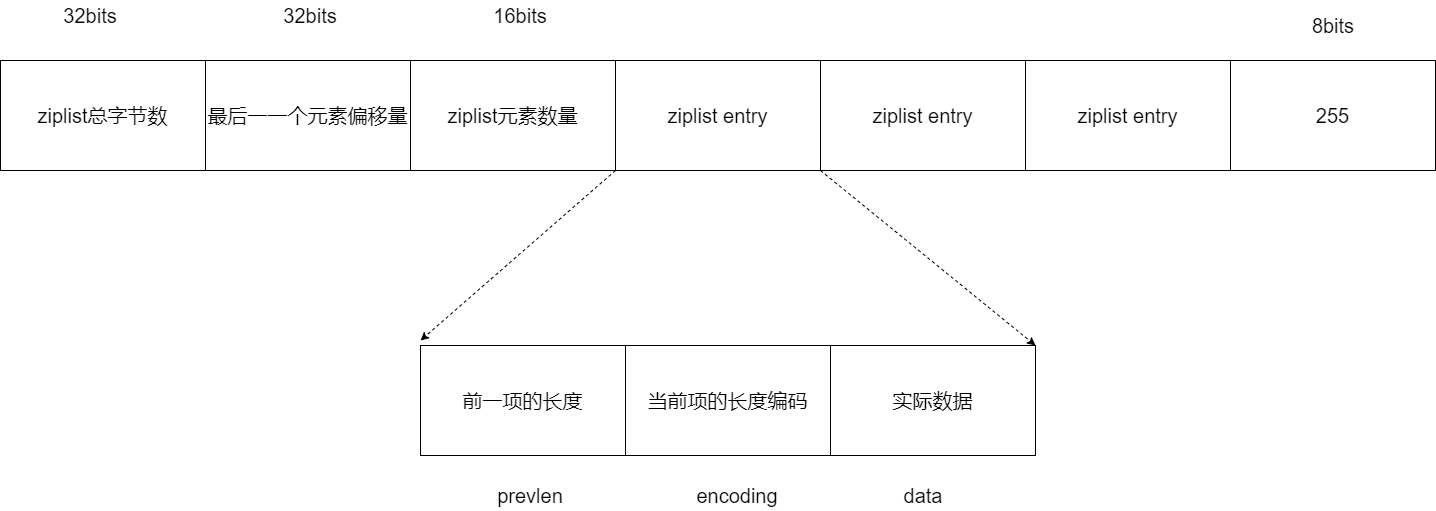Redis内存友好的数据结构设计
内存友好的数据结构
首先要知道,在 Redis 中,有三种数据结构针对内存使用效率做了设计优化,分别是简单
- 动态字符串(SDS)
- 压缩列表(ziplist)
- 整数集合(intset)。
下面,我们就分别来学 习一下。
SDS 的内存友好设计
SDS 设计了不同类型的结构头,包括 sdshdr8、sdshdr16、sdshdr32 和 sdshdr64。这些不同类型的结构头可以适配不同大小的字符串,从而避免了内存浪费。
不过,SDS 除了使用精巧设计的结构头外,在保存较小字符串时,其实还使用了嵌入式字符串的设计方法。这种方法避免了给字符串分配额外的空间,而是可以让字符串直接保存 在 Redis 的基本数据对象结构体中。
所以这也就是说,要想理解嵌入式字符串的设计与实现,我们就需要先来了解下,Redis 使用的基本数据对象结构体 redisObject 是什么样的。
redisObject 结构体与位域定义方法 redisObject 结构体是在 server.h 文件中定义的,主要功能是用来保存键值对中的值。这 个结构一共定义了 4 个元数据和一个指针。
-
type:redisObject 的数据类型,是应用程序在 Redis 中保存的数据类型,包括 String、List、Hash 等。
-
encoding:redisObject 的编码类型,是 Redis 内部实现各种数据类型所用的数据结构。
-
lru:redisObject 的 LRU 时间。
-
refcount:redisObject 的引用计数。
-
ptr:指向值的指针。
下面的代码展示了 redisObject 结构体的定义:
typedef struct redisObject {
// redisObject的数据类型,4个bits
unsigned type:4;
// redisObject的编码类型,4个bits
unsigned encoding:4;
//redisObject的LRU时间,LRU_BITS为24个bits
unsigned lru:LRU_BITS; /* LRU time (relative to global lru_clock) or
* LFU data (least significant 8 bits frequency
* and most significant 16 bits access time). */
// redisObject的引用计数,4个字节
int refcount;
// 指向值的指针,8个字节
void *ptr;
} robj;
从代码中我们可以看到,在 type、encoding 和 lru 三个变量后面都有一个冒号,并紧跟着一个数值,表示该元数据占用的比特数。其中,type 和 encoding 分别占 4bits。而 lru 占用的比特数,是由 server.h 中的宏定义 LRU_BITS 决定的,它的默认值是 24bits(最低有效 8 位表示频率和最高有效 16 位表示访问时间),如下 所示:

而这里我想让你学习掌握的,就是这种变量后使用冒号和数值的定义方法。这实际上是 C 语言中的位域定义方法,可以用来有效地节省内存开销。
这种方法比较适用的场景是,当一个变量占用不了一个数据类型的所有 bits 时,就可以使 用位域定义方法,把一个数据类型中的 bits,划分成多个位域,每个位域占一定的 bit 数。这样一来,一个数据类型的所有 bits 就可以定义多个变量了,从而也就有效节省了内 存开销。
此外,你可能还会发现,对于 type、encoding 和 lru 三个变量来说,它们的数据类型都 是 unsigned。已知一个 unsigned 类型是 4 字节,但这三个变量,是分别占用了一个 unsigned 类型 4 字节中的 4bits、4bits 和 24bits。因此,相较于三个变量,每个变量用 一个 4 字节的 unsigned 类型定义来说,使用位域定义方法可以让三个变量只用 4 字节, 最后就能节省 8 字节的开销。 所以,当你在设计开发内存敏感型的软件时,就可以把这种位域定义方法使用起来。 好,了解了 redisObject 结构体和它使用的位域定义方法以后,我们再来看嵌入式字符串 是如何实现的。
嵌入式字符串
SDS 在保存比较小的字符串时,会使用嵌入式字符串的设计方法,将字符串直接保存在redisObject 结构体中。然后在 redisObject 结构体中,存在一个指向值的指 针 ptr,而一般来说,这个 ptr 指针会指向值的数据结构。
这里我们就以创建一个 String 类型的值为例,Redis 会调用 createStringObject 函数, 来创建相应的 redisObject,而这个 redisObject 中的 ptr 指针,就会指向 SDS 数据结 构,如下图所示。

在 Redis 源码中,createStringObject 函数会根据要创建的字符串的长度,决定具体调用哪个函数来完成创建。
那么针对这个 createStringObject 函数来说,它的参数是字符串 ptr 和字符串长度 len。
- 当 len 的长度大于 OBJ_ENCODING_EMBSTR_SIZE_LIMIT 这个宏定义时, createStringObject 函数会调用 createRawStringObject 函数,否则就调用 createEmbeddedStringObject 函数。
而在我们分析的 Redis 6.2.6 源码版本中,这个 OBJ_ENCODING_EMBSTR_SIZE_LIMIT 默认定义为 44 字节。
/* Create a string object with EMBSTR encoding if it is smaller than
* OBJ_ENCODING_EMBSTR_SIZE_LIMIT, otherwise the RAW encoding is
* used.
*
* The current limit of 44 is chosen so that the biggest string object
* we allocate as EMBSTR will still fit into the 64 byte arena of jemalloc. */
#define OBJ_ENCODING_EMBSTR_SIZE_LIMIT 44
robj *createStringObject(const char *ptr, size_t len) {
//创建嵌入式字符串,字符串长度小于等于44字节
if (len <= OBJ_ENCODING_EMBSTR_SIZE_LIMIT)
return createEmbeddedStringObject(ptr,len);
//创建普通字符串,字符串长度大于44字节
else
return createRawStringObject(ptr,len);
}
现在,我们就来分析一下 createStringObject 函数的源码实现,以此了解大于 44 字节的 普通字符串和小于等于 44 字节的嵌入式字符串分别是如何创建的。
首先,对于 createRawStringObject 函数来说,它在创建 String 类型的值的时候,会调用 createObject 函数。
补充:createObject 函数主要是用来创建 Redis 的数据对象的。因为 Redis 的数据对象有很多类型,比如 String、List、Hash 等,所以在 createObject 函数的两个参数 中,有一个就是用来表示所要创建的数据对象类型,而另一个是指向数据对象的指针。
然后,createRawStringObject 函数在调用 createObject 函数时,会传递 OBJ_STRING 类型,表示要创建 String 类型的对象,以及传递指向 SDS 结构的指针,如以下代码所示。这里需要注意的是,指向 SDS 结构的指针是由 sdsnewlen 函数返回的,而 sdsnewlen 函数正是用来创建 SDS 结构的。
/* Create a string object with encoding OBJ_ENCODING_RAW, that is a plain
* string object where o->ptr points to a proper sds string. */
robj *createRawStringObject(const char *ptr, size_t len) {
return createObject(OBJ_STRING, sdsnewlen(ptr,len));
}
最后,我们再来进一步看下 createObject 函数。这个函数会把参数中传入的、指向 SDS 结构体的指针直接赋值给 redisObject 中的 ptr,这部分的代码如下所示:
robj *createObject(int type, void *ptr) {
// 给redisObject结构体分配空间
robj *o = zmalloc(sizeof(*o));
// 设置redisObject的类型
o->type = type;
// 设置redisObject的编码类型,此处是OBJ_ENCODING_RAW,表示常规的SDS
o->encoding = OBJ_ENCODING_RAW;
// 直接将传入的指针赋值给redisObject中的指针。
o->ptr = ptr;
o->refcount = 1;
// 将LRU设置为当前lruclock(分钟执行率),或者设置LFU计数器
/* Set the LRU to the current lruclock (minutes resolution), or
* alternatively the LFU counter. */
if (server.maxmemory_policy & MAXMEMORY_FLAG_LFU) {
o->lru = (LFUGetTimeInMinutes()<<8) | LFU_INIT_VAL;
} else {
o->lru = LRU_CLOCK();
}
return o;
}
为了方便理解普通字符串创建方法,我画了一张图,你可以看下。

这也就是说,在创建普通字符串时,Redis 需要分别给 redisObject 和 SDS 分别分配一次 内存,这样就既带来了内存分配开销,同时也会导致内存碎片。因此,当字符串小于等于 44 字节时,Redis 就使用了嵌入式字符串的创建方法,以此减少内存分配和内存碎片。
而这个创建方法,就是由我们前面提到的 createEmbeddedStringObject 函数来完成 的,该函数会使用一块连续的内存空间,来同时保存 redisObject 和 SDS 结构。这样一 来,内存分配只有一次,而且也避免了内存碎片。
createEmbeddedStringObject 函数的原型定义如下,它的参数就是从 createStringObject 函数参数中获得的字符串指针 ptr,以及字符串长度 len。函数完整代码如下,下面我们来逐步逐步分析:
robj *createEmbeddedStringObject(const char *ptr, size_t len) {
// 分配一块连续的内存空间,这块内存空间的大小等于redisObject结构体的大小、SDS结构头 sdshdr8 的大小和字符串大小的总和,并且再加上 1 字节
robj *o = zmalloc(sizeof(robj)+sizeof(struct sdshdr8)+len+1);
// 创建 SDS结构的指针sh,并把sh指向这块连续空间中SDS结构头所在的位置
struct sdshdr8 *sh = (void*)(o+1);
o->type = OBJ_STRING;
o->encoding = OBJ_ENCODING_EMBSTR;
// sh+1表示把内存地址从sh起始地址开始移动一定的大小,移动的距离等于sdshdr8结构体的大小
o->ptr = sh+1;
o->refcount = 1;
if (server.maxmemory_policy & MAXMEMORY_FLAG_LFU) {
o->lru = (LFUGetTimeInMinutes()<<8) | LFU_INIT_VAL;
} else {
o->lru = LRU_CLOCK();
}
sh->len = len;
sh->alloc = len;
sh->flags = SDS_TYPE_8;
// 把参数中传入的指针 ptr 指向的字符串,拷贝到SDS结构体中的字符数组,并在数组最后添加结束字符
if (ptr == SDS_NOINIT)
sh->buf[len] = '\0';
else if (ptr) {
memcpy(sh->buf,ptr,len);
sh->buf[len] = '\0';
} else {
memset(sh->buf,0,len+1);
}
return o;
}
首先,createEmbeddedStringObject 函数会分配一块连续的内存空间,这块内存空间的 大小等于 redisObject 结构体的大小、SDS 结构头 sdshdr8 的大小和字符串大小的总和, 并且再加上 1 字节。注意,这里最后的 1 字节是 SDS 中加在字符串最后的结束字 符“\0”。
robj *o = zmalloc(sizeof(robj)+sizeof(struct sdshdr8)+len+1);

那么 createEmbeddedStringObject 函数在分配了内存空间之后,就会创建 SDS 结 构的指针 sh,并把 sh 指向这块连续空间中 SDS 结构头所在的位置,下面的代码显示了这步操作。其中,o 是 redisObject 结构体的变量,o+1 表示将内存地址从变量 o 开始移动 一段距离,而移动的距离等于 redisObject 这个结构体的大小。
struct sdshdr8 *sh = (void*)(o+1);
经过这步操作后,sh 指向的位置就如下图所示:

紧接着,createEmbeddedStringObject 函数会把 redisObject 中的指针 ptr,指向 SDS 结构中的字符数组。 如以下代码所示,其中 sh 是刚才介绍的指向 SDS 结构的指针,属于 sdshdr8 类型。而 sh+1 表示把内存地址从 sh 起始地址开始移动一定的大小,移动的距离等于 sdshdr8 结构 体的大小。
o->ptr = sh+1;

最后,createEmbeddedStringObject 函数会把参数中传入的指针 ptr 指向的字符串,拷贝到 SDS 结构体中的字符数组,并在数组最后添加结束字符。这部分代码如下所示:
memcpy(sh->buf,ptr,len);
sh->buf[len] = '\0';
下面这张图,也展示了 createEmbeddedStringObject 创建嵌入式字符串的过程,你可以 再整体来看看。

总之,你可以记住,Redis 会通过设计实现一块连续的内存空间,把 redisObject 结构体 和 SDS 结构体紧凑地放置在一起。这样一来,对于不超过 44 字节的字符串来说,就可以避免内存碎片和两次内存分配的开销了。 而除了嵌入式字符串之外,Redis 还设计了压缩列表和整数集合,这也是两种紧凑型的内 存数据结构,所以下面我们再来学习下它们的设计思路。
压缩列表和整数集合的设计
首先你要知道,List、Hash 和 Sorted Set 这三种数据类型,都可以使用压缩列表 (ziplist)来保存数据。压缩列表的函数定义和实现代码分别在 ziplist.h 和 ziplist.c 中。
不过,我们在 ziplist.h 文件中其实根本看不到压缩列表的结构体定义。这是因为压缩列表 本身就是一块连续的内存空间,它通过使用不同的编码来保存数据。
这里为了方便理解压缩列表的设计与实现,我们先来看看它的创建函数 ziplistNew,如下 所示:
/* Create a new empty ziplist. */
unsigned char *ziplistNew(void) {
// 初始分配的大小
unsigned int bytes = ZIPLIST_HEADER_SIZE+ZIPLIST_END_SIZE;
unsigned char *zl = zmalloc(bytes);
ZIPLIST_BYTES(zl) = intrev32ifbe(bytes);
ZIPLIST_TAIL_OFFSET(zl) = intrev32ifbe(ZIPLIST_HEADER_SIZE);
ZIPLIST_LENGTH(zl) = 0;
// 将列表尾设置为ZIP_END
zl[bytes-1] = ZIP_END;
return zl;
}
实际上,ziplistNew 函数的逻辑很简单,就是创建一块连续的内存空间,大小为 ZIPLIST_HEADER_SIZE 和 ZIPLIST_END_SIZE 的总和,然后再把该连续空间的最后一个 字节赋值为 ZIPLIST_ENTRY_END,表示列表结束。
另外你要注意的是,在上面代码中定义的三个宏 ZIPLIST_HEADER_SIZE、 ZIPLIST_END_SIZE 和 ZIPLIST_ENTRY_END,在 ziplist.c 中也分别有定义,分别表示 ziplist 的列表头 大小、列表尾大小和列表尾字节内容,如下所示。
/* The size of a ziplist header: two 32 bit integers for the total
* bytes count and last item offset. One 16 bit integer for the number
* of items field. */
// ziplist的列表头大小,包括2个32 bits整数和1个16bits整数,分别表示压缩列表的总字节数,列表最后一项偏移量
#define ZIPLIST_HEADER_SIZE (sizeof(uint32_t)*2+sizeof(uint16_t))
// ziplist的列表尾大小,包括1个8 bits整数,表示列表结束。
/* Size of the "end of ziplist" entry. Just one byte. */
#define ZIPLIST_END_SIZE (sizeof(uint8_t))
// 头指针
/* Return the pointer to the first entry of a ziplist. */
#define ZIPLIST_ENTRY_HEAD(zl) ((zl)+ZIPLIST_HEADER_SIZE)
// 尾指针
/* Return the pointer to the last entry of a ziplist, using the
* last entry offset inside the ziplist header. */
#define ZIPLIST_ENTRY_TAIL(zl) ((zl)+intrev32ifbe(ZIPLIST_TAIL_OFFSET(zl)))
// 返回ziplist的最后一个字节的指针,即 *ziplist FF入口的末尾。
/* Return the pointer to the last byte of a ziplist, which is, the
* end of ziplist FF entry. */
#define ZIPLIST_ENTRY_END(zl) ((zl)+intrev32ifbe(ZIPLIST_BYTES(zl))-1)
那么,在创建一个新的 ziplist 后,该列表的内存布局就如下图所示。注意,此时列表中还没有实际的数据。

然后,当我们往 ziplist 中插入数据时,ziplist 就会根据数据是字符串还是整数,以及它们 的大小进行不同的编码。这种根据数据大小进行相应编码的设计思想,正是 Redis 为了节 省内存而采用的。
**那么,ziplist 是如何进行编码呢?**要学习编码的实现,我们要先了解 ziplist 中列表项的结构。 ziplist 列表项包括三部分内容,分别是前一项的长度(prevlen)、当前项长度信息的编码结果(encoding),以及当前项的实际数据(data)。下面的图展示了列表项的结构 (图中除列表项之外的内容分别是 ziplist 内存空间的起始和尾部)。

实际上,所谓的编码技术,就是指用不同数量的字节来表示保存的信息。在 ziplist 中,编码技术主要应用在列表项中的 prevlen 和 encoding 这两个元数据上。而当前项的实际数据 data,则正常用整数或是字符串来表示。
所以这里,我们就先来看下 prevlen 的编码设计。ziplist 中会包含多个列表项,每个列表 项都是紧挨着彼此存放的,如下图所示:

而为了方便查找,每个列表项中都会记录前一项的长度。因为每个列表项的长度不一样, 所以如果使用相同的字节大小来记录 prevlen,就会造成内存空间浪费。
我给你举个例子,假设我们统一使用 4 字节记录 prevlen,如果前一个列表项只是一个字符串“redis”,长度为 5 个字节,那么我们用 1 个字节(8 bits)就能表示 256 位长度 (2 的 8 次方等于 256)的字符串了。此时,prevlen 用 4 字节记录,其中就有 3 字节是浪费掉了。
好,我们再回过头来看,ziplist 在对 prevlen 编码时,会先调用 zipStorePrevEntryLength 函数,用于判断前一个列表项是否小于 254 字节。如果是的 话,那么 prevlen 就使用 1 字节表示;否则,zipStorePrevEntryLength 函数就调用 zipStorePrevEntryLengthLarge 函数进一步编码。这部分代码如下所示:
/* Encode the length of the previous entry and write it to "p". Return the
* number of bytes needed to encode this length if "p" is NULL. */
unsigned int zipStorePrevEntryLength(unsigned char *p, unsigned int len) {
if (p == NULL) {
return (len < ZIP_BIG_PREVLEN) ? 1 : sizeof(uint32_t) + 1;
} else {
// 判断prevlen的长度是否小于ZIP_BIG_PREVLEN,ZIP_BIG_PREVLEN等于254
if (len < ZIP_BIG_PREVLEN) {
// 如果小于254位,那么返回prevlen为1字节
p[0] = len;
return 1;
} else {
// 否则,调用zipStorePrevEntryLengthLarge进行编码
return zipStorePrevEntryLengthLarge(p,len);
}
}
}
下面我们来看zipStorePrevEntryLengthLarge ,zipStorePrevEntryLengthLarge 函数会先将 prevlen 的第 1 字节设置为 254,然后使用内存拷贝函数 memcpy,将前一个列表项的长度值拷贝至 prevlen 的第2至第5字节。最后,zipStorePrevEntryLengthLarge 函数返回 prevlen 的大小,为 5 字节。
/* Encode the length of the previous entry and write it to "p". This only
* uses the larger encoding (required in __ziplistCascadeUpdate). */
int zipStorePrevEntryLengthLarge(unsigned char *p, unsigned int len) {
uint32_t u32;
if (p != NULL) {
// 将prevlen的第1字节设置为ZIP_BIG_PREVLEN,即254
p[0] = ZIP_BIG_PREVLEN;
u32 = len;
// 将前一个列表项的长度值拷贝至prevlen的第2至第5字节,其中sizeof(uint32_t)的值为4
memcpy(p+1,&u32,sizeof(u32));
memrev32ifbe(p+1);
}
return 1 + sizeof(uint32_t);
}
好,在了解了 prevlen 使用 1 字节和 5 字节两种编码方式后,我们再来学习下 encoding 的编码方法。
我们知道,一个列表项的实际数据,既可以是整数也可以是字符串。整数可以是 16、32、 64 等字节长度,同时字符串的长度也可以大小不一。
所以,ziplist 在 zipStoreEntryEncoding 函数中,针对整数和字符串,就分别使用了不同 字节长度的编码结果。下面的代码展示了zipStoreEntryEncoding 函数的部分代码,你可 以看到当数据是不同长度字符串或是整数时,编码结果的长度 len 大小不同。
/* Write the encoding header of the entry in 'p'. If p is NULL it just returns
* the amount of bytes required to encode such a length. Arguments:
*
* 'encoding' is the encoding we are using for the entry. It could be
* ZIP_INT_* or ZIP_STR_* or between ZIP_INT_IMM_MIN and ZIP_INT_IMM_MAX
* for single-byte small immediate integers.
*
* 'rawlen' is only used for ZIP_STR_* encodings and is the length of the
* string that this entry represents.
*
* The function returns the number of bytes used by the encoding/length
* header stored in 'p'. */
unsigned int zipStoreEntryEncoding(unsigned char *p, unsigned char encoding, unsigned int rawlen) {
// 默认编码结果是1字节
unsigned char len = 1, buf[5];
// 如果是字符串数据
if (ZIP_IS_STR(encoding)) {
/* Although encoding is given it may not be set for strings,
* so we determine it here using the raw length. */
// 字符串长度小于等于63字节(16进制为0x3f)
if (rawlen <= 0x3f) {
// 默认编码结果是1字节
if (!p) return len;
buf[0] = ZIP_STR_06B | rawlen;
}
// 字符串长度小于等于16383字节(16进制为0x3fff)
else if (rawlen <= 0x3fff) {
// 编码结果是2字节
len += 1;
if (!p) return len;
buf[0] = ZIP_STR_14B | ((rawlen >> 8) & 0x3f);
buf[1] = rawlen & 0xff;
} else {
// 字符串长度大于16383字节
// 编码结果是5字节
len += 4;
if (!p) return len;
buf[0] = ZIP_STR_32B;
buf[1] = (rawlen >> 24) & 0xff;
buf[2] = (rawlen >> 16) & 0xff;
buf[3] = (rawlen >> 8) & 0xff;
buf[4] = rawlen & 0xff;
}
} else {
/* Implies integer encoding, so length is always 1. */
/* 如果数据是整数,编码结果是1字节*/
if (!p) return len;
buf[0] = encoding;
}
/* Store this length at p. */
memcpy(p,buf,len);
return len;
}
可以归结为下面这张图

简而言之,针对不同长度的数据,使用不同大小的元数据信息(prevlen 和 encoding), 这种方法可以有效地节省内存开销。当然,除了 ziplist 之外,Redis 还设计了一个内存友 好的数据结构,这就是整数集合(intset),它是作为底层结构来实现 Set 数据类型的。
和 SDS 嵌入式字符串、ziplist 类似,整数集合也是一块连续的内存空间,这一点我们从整数集合的定义中就可以看到。intset.h 和 intset.c 分别包括了整数集合的定义和实现。
下面的代码展示了 intset 的结构定义。我们可以看到,整数集合结构体中记录数据的部分,就是一个int8_t 类型的整数数组 contents。从内存使用的角度来看,整数数组就是一块连续内存空间,所以这样就避免了内存碎片,并提升了内存使用效率。
typedef struct intset {
uint32_t encoding;
uint32_t length;
int8_t contents[];
} intset;
好了,到这里,我们就已经了解了 Redis 针对内存开销所做的数据结构优化,分别是 SDS 嵌入式字符串、压缩列表和整数集合。
而除了对数据结构做优化,Redis 在数据访问上,也会尽量节省内存开销,接下来我们就 一起来学习下。
节省内存的数据访问
我们知道,在 Redis 实例运行时,有些数据是会被经常访问的,比如常见的整数,Redis 协议中常见的回复信息,包括操作成功(“OK”字符串)、操作失败(ERR),以及常见的报错信息。
所以,为了避免在内存中反复创建这些经常被访问的数据,Redis 就采用了共享对象的设计思想。这个设计思想很简单,就是把这些常用数据创建为共享对象,当上层应用需要访问它们时,直接读取就行。
现在我们就来做个假设。有 1000 个客户端,都要保存“3”这个整数。如果 Redis 为每个 客户端,都创建了一个值为 3 的 redisObject,那么内存中就会有大量的冗余。而使用了 共享对象方法后,Redis 在内存中只用保存一个 3 的 redisObject 就行,这样就有效节省 了内存空间。
以下代码展示的是 server.c 文件中,创建共享对象的函数 createSharedObjects,你可 以看下。
void createSharedObjects(void) {
int j;
/* Shared command responses */
// 常见回复信息
shared.crlf = createObject(OBJ_STRING,sdsnew("\r\n"));
shared.ok = createObject(OBJ_STRING,sdsnew("+OK\r\n"));
shared.emptybulk = createObject(OBJ_STRING,sdsnew("$0\r\n\r\n"));
shared.czero = createObject(OBJ_STRING,sdsnew(":0\r\n"));
shared.cone = createObject(OBJ_STRING,sdsnew(":1\r\n"));
shared.emptyarray = createObject(OBJ_STRING,sdsnew("*0\r\n"));
shared.pong = createObject(OBJ_STRING,sdsnew("+PONG\r\n"));
shared.queued = createObject(OBJ_STRING,sdsnew("+QUEUED\r\n"));
shared.emptyscan = createObject(OBJ_STRING,sdsnew("*2\r\n$1\r\n0\r\n*0\r\n"));
shared.space = createObject(OBJ_STRING,sdsnew(" "));
shared.colon = createObject(OBJ_STRING,sdsnew(":"));
shared.plus = createObject(OBJ_STRING,sdsnew("+"));
/* Shared command error responses */
// 常见报错信息
shared.wrongtypeerr = createObject(OBJ_STRING,sdsnew(
"-WRONGTYPE Operation against a key holding the wrong kind of value\r\n"));
shared.err = createObject(OBJ_STRING,sdsnew("-ERR\r\n"));
shared.nokeyerr = createObject(OBJ_STRING,sdsnew(
"-ERR no such key\r\n"));
shared.syntaxerr = createObject(OBJ_STRING,sdsnew(
"-ERR syntax error\r\n"));
shared.sameobjecterr = createObject(OBJ_STRING,sdsnew(
"-ERR source and destination objects are the same\r\n"));
shared.outofrangeerr = createObject(OBJ_STRING,sdsnew(
"-ERR index out of range\r\n"));
shared.noscripterr = createObject(OBJ_STRING,sdsnew(
"-NOSCRIPT No matching script. Please use EVAL.\r\n"));
shared.loadingerr = createObject(OBJ_STRING,sdsnew(
"-LOADING Redis is loading the dataset in memory\r\n"));
shared.slowscripterr = createObject(OBJ_STRING,sdsnew(
"-BUSY Redis is busy running a script. You can only call SCRIPT KILL or SHUTDOWN NOSAVE.\r\n"));
shared.masterdownerr = createObject(OBJ_STRING,sdsnew(
"-MASTERDOWN Link with MASTER is down and replica-serve-stale-data is set to 'no'.\r\n"));
shared.bgsaveerr = createObject(OBJ_STRING,sdsnew(
"-MISCONF Redis is configured to save RDB snapshots, but it is currently not able to persist on disk. Commands that may modify the data set are disabled, because this instance is configured to report errors during writes if RDB snapshotting fails (stop-writes-on-bgsave-error option). Please check the Redis logs for details about the RDB error.\r\n"));
shared.roslaveerr = createObject(OBJ_STRING,sdsnew(
"-READONLY You can't write against a read only replica.\r\n"));
shared.noautherr = createObject(OBJ_STRING,sdsnew(
"-NOAUTH Authentication required.\r\n"));
shared.oomerr = createObject(OBJ_STRING,sdsnew(
"-OOM command not allowed when used memory > 'maxmemory'.\r\n"));
shared.execaborterr = createObject(OBJ_STRING,sdsnew(
"-EXECABORT Transaction discarded because of previous errors.\r\n"));
shared.noreplicaserr = createObject(OBJ_STRING,sdsnew(
"-NOREPLICAS Not enough good replicas to write.\r\n"));
shared.busykeyerr = createObject(OBJ_STRING,sdsnew(
"-BUSYKEY Target key name already exists.\r\n"));
/* The shared NULL depends on the protocol version. */
// 共享空值取决于协议版本
shared.null[0] = NULL;
shared.null[1] = NULL;
shared.null[2] = createObject(OBJ_STRING,sdsnew("$-1\r\n"));
shared.null[3] = createObject(OBJ_STRING,sdsnew("_\r\n"));
shared.nullarray[0] = NULL;
shared.nullarray[1] = NULL;
shared.nullarray[2] = createObject(OBJ_STRING,sdsnew("*-1\r\n"));
shared.nullarray[3] = createObject(OBJ_STRING,sdsnew("_\r\n"));
shared.emptymap[0] = NULL;
shared.emptymap[1] = NULL;
shared.emptymap[2] = createObject(OBJ_STRING,sdsnew("*0\r\n"));
shared.emptymap[3] = createObject(OBJ_STRING,sdsnew("%0\r\n"));
shared.emptyset[0] = NULL;
shared.emptyset[1] = NULL;
shared.emptyset[2] = createObject(OBJ_STRING,sdsnew("*0\r\n"));
shared.emptyset[3] = createObject(OBJ_STRING,sdsnew("~0\r\n"));
for (j = 0; j < PROTO_SHARED_SELECT_CMDS; j++) {
char dictid_str[64];
int dictid_len;
dictid_len = ll2string(dictid_str,sizeof(dictid_str),j);
shared.select[j] = createObject(OBJ_STRING,
sdscatprintf(sdsempty(),
"*2\r\n$6\r\nSELECT\r\n$%d\r\n%s\r\n",
dictid_len, dictid_str));
}
shared.messagebulk = createStringObject("$7\r\nmessage\r\n",13);
shared.pmessagebulk = createStringObject("$8\r\npmessage\r\n",14);
shared.subscribebulk = createStringObject("$9\r\nsubscribe\r\n",15);
shared.unsubscribebulk = createStringObject("$11\r\nunsubscribe\r\n",18);
shared.psubscribebulk = createStringObject("$10\r\npsubscribe\r\n",17);
shared.punsubscribebulk = createStringObject("$12\r\npunsubscribe\r\n",19);
/* Shared command names */
// 命令名字
shared.del = createStringObject("DEL",3);
shared.unlink = createStringObject("UNLINK",6);
shared.rpop = createStringObject("RPOP",4);
shared.lpop = createStringObject("LPOP",4);
shared.lpush = createStringObject("LPUSH",5);
shared.rpoplpush = createStringObject("RPOPLPUSH",9);
shared.lmove = createStringObject("LMOVE",5);
shared.blmove = createStringObject("BLMOVE",6);
shared.zpopmin = createStringObject("ZPOPMIN",7);
shared.zpopmax = createStringObject("ZPOPMAX",7);
shared.multi = createStringObject("MULTI",5);
shared.exec = createStringObject("EXEC",4);
shared.hset = createStringObject("HSET",4);
shared.srem = createStringObject("SREM",4);
shared.xgroup = createStringObject("XGROUP",6);
shared.xclaim = createStringObject("XCLAIM",6);
shared.script = createStringObject("SCRIPT",6);
shared.replconf = createStringObject("REPLCONF",8);
shared.pexpireat = createStringObject("PEXPIREAT",9);
shared.pexpire = createStringObject("PEXPIRE",7);
shared.persist = createStringObject("PERSIST",7);
shared.set = createStringObject("SET",3);
shared.eval = createStringObject("EVAL",4);
/* Shared command argument */
// 命令参数
shared.left = createStringObject("left",4);
shared.right = createStringObject("right",5);
shared.pxat = createStringObject("PXAT", 4);
shared.px = createStringObject("PX",2);
shared.time = createStringObject("TIME",4);
shared.retrycount = createStringObject("RETRYCOUNT",10);
shared.force = createStringObject("FORCE",5);
shared.justid = createStringObject("JUSTID",6);
shared.lastid = createStringObject("LASTID",6);
shared.default_username = createStringObject("default",7);
shared.ping = createStringObject("ping",4);
shared.setid = createStringObject("SETID",5);
shared.keepttl = createStringObject("KEEPTTL",7);
shared.load = createStringObject("LOAD",4);
shared.createconsumer = createStringObject("CREATECONSUMER",14);
shared.getack = createStringObject("GETACK",6);
shared.special_asterick = createStringObject("*",1);
shared.special_equals = createStringObject("=",1);
shared.redacted = makeObjectShared(createStringObject("(redacted)",10));
// 0到9999的整数
for (j = 0; j < OBJ_SHARED_INTEGERS; j++) {
shared.integers[j] =
makeObjectShared(createObject(OBJ_STRING,(void*)(long)j));
shared.integers[j]->encoding = OBJ_ENCODING_INT;
}
for (j = 0; j < OBJ_SHARED_BULKHDR_LEN; j++) {
shared.mbulkhdr[j] = createObject(OBJ_STRING,
sdscatprintf(sdsempty(),"*%d\r\n",j));
shared.bulkhdr[j] = createObject(OBJ_STRING,
sdscatprintf(sdsempty(),"$%d\r\n",j));
}
/* The following two shared objects, minstring and maxstrings, are not
* actually used for their value but as a special object meaning
* respectively the minimum possible string and the maximum possible
* string in string comparisons for the ZRANGEBYLEX command. */
shared.minstring = sdsnew("minstring");
shared.maxstring = sdsnew("maxstring");
}
降低内存开销,对于 Redis 这样的内存数据库来说非常重要。今天这节课,我们了解了 Redis 用于优化内存使用效率的两种方法:
-
- 内存优化的数据结构设计
-
- 节省内存的共享数据访问。
那么,对于实现数据结构来说,如果想要节省内存,Redis 就给我们提供了两个优秀的设计思想:
- 一个是使用连续的内存空间,避免内存碎片开销;
- 二个是针对不同长度的数据, 采用不同大小的元数据,以避免使用统一大小的元数据,造成内存空间的浪费。
另外在数据访问方面,你也要知道,使用共享对象其实可以避免重复创建冗余的数据,从而也可以有效地节省内存空间。不过,共享对象主要适用于只读场景,如果一个字符串被反复地修改,就无法被多个请求共享访问了。所以这一点,你在应用时也需要注意一下。
以上绝大部分来源于极客时间的redis源码专栏课,小部分是我自己绘制的图,以及从redis6.2.6源码中贴的实际代码。